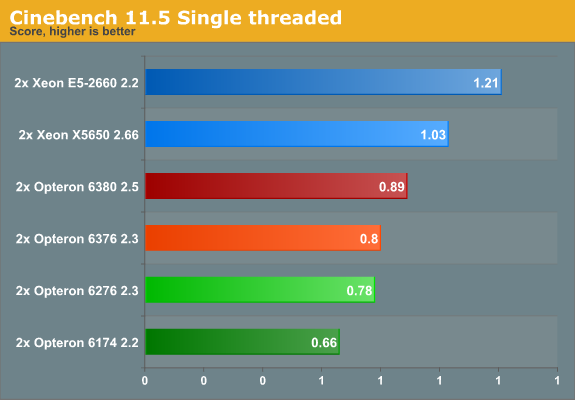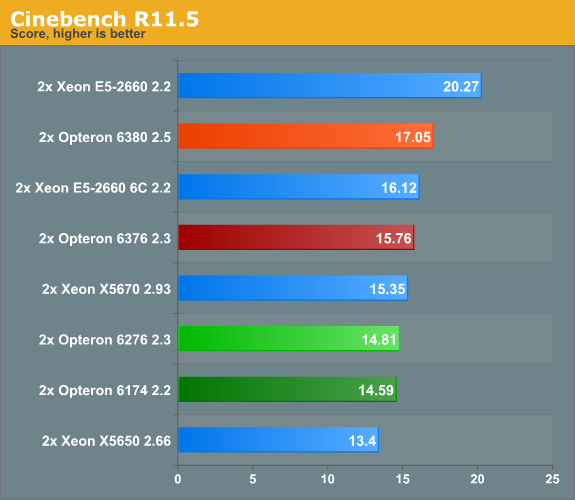The new Opteron 6300: Finally Tested!
by Johan De Gelas on February 20, 2013 12:03 AM ESTRendering Performance: Cinebench
Cinebench, based on MAXON's CINEMA 4D software, is probably one of the most popular benchmarks around as it is pretty easy to perform this benchmark on your own home machine. The benchmark supports 64 threads, more than enough for our 24- and 32-thread test servers. First we test single-threaded performance, to evaluate the performance of each core.

Cinebench achieves an IPC between 1.4 and 1.8 and is mostly dominated by SSE2 code. The new Opteron is clock-for-clock about 3% more efficient. Let's check out the multi-threaded score.

The Opteron 6300 is about 6% faster than its predecessor at the same clockspeed. People in the rendering market tend to go for the best and still affordable performance. A few hundred dollars more can easily be recouped if your rendering is finished earlier. This remains Intel territory.










55 Comments
View All Comments
JohanAnandtech - Wednesday, February 20, 2013 - link
Per Core. So with the -np 32 setting. I have tried less before, but the LS-DYNA really likes the extra load and store units of the second unit. so 32 MPI processes give a 30% boost.alpha754293 - Wednesday, February 20, 2013 - link
That's a healthy boost! It's amazing how these technologies are maturing to the point where conventional wisdom that they might be starved for FPU resources isn't enough to slow them down.It'd be interesting to see whether it makes a difference if you were to let the OS handle the job/process scheduling or whether manual intervention can help reduce some of the thread/process migration overhead, especially across 16 FPUs.
dmytty - Friday, February 22, 2013 - link
Before the benchmarks came in, I looked at an HPC build for the new 6300 series. I saw the real sweet spot for AMD being the 6344 which is a CPU of type 2.6 Ghz @ 12 or 6 core (depending how you define a 'core'). Anandtech never mentioned this CPU in the review. (?)In simple $ terms for the CPU, it's the E5 2640 @ $815 vs the Opteron 6344 @ $415. So how does AMD not have a decisive price advantage?
In 4S land the price advantage widens.
AMD 4S...I priced a build (not including a case) at ~$3860 for 4 x 6344, 128 GB RAM, mobo and PSU. Note that this mobo could also go out to 256 GB. CPU cost is 4 x 6344 = $1660. Again, total system cost was $3860.
Intel 4S...I picked the 4607 as being the best 'bang for the buck processor'. It's 6 cores @ 2.2 Ghz. However, at $885 per 4607 processor the CPU cost is more than double than AMD (ie 4x Intel 4607 = $3540). The same build cost using the Intel 4607 would then be $5740.
AMD @ $3860 vs Intel @ $5740. Why did Anandtech not talk about 4S? Why no mention of the 6344?
dmytty - Friday, February 22, 2013 - link
I forgot to mention that the Intel board I specified for 4S build was $1200 whereas the AMD board was $800.A marketing person would call the system cost comparison ~$3k vs $~6k.
Again, am I missing something?
The AMD 6344 based 4S system has a ~19% clockspeed advantage and comes in at 62% of the cost.
Worried about electrical cost? You can buy 700 watts of PV solar panels with the cost savings between AMD and Intel. 700 watts peak = ~3.5 kwh daily output. That would nicely mitigate (and then some) the 20 watts/cpu difference (80 watts total with 4x cpu) between AMD 6344 and Intel 4607. You would net about 1.5 kwh/day electricity going with the AMD + PV over the slightly more efficient Intel.
geok1ng - Monday, May 19, 2014 - link
this is all and good, but looking at spec int 2006 results, Abu Dhabi still does not match performance/watt of Magni Cours opterons. And the best competition AMd can offer against 2 gen old Xeons is still the Opteron 6180.